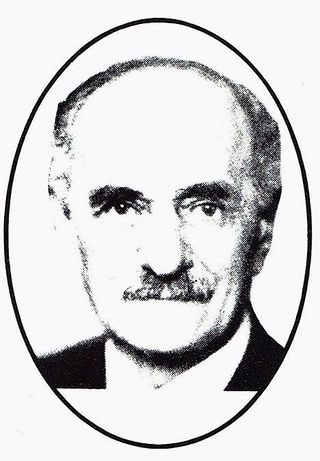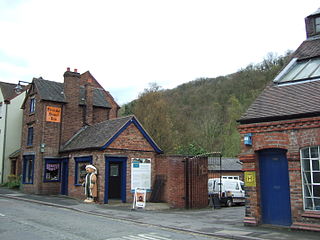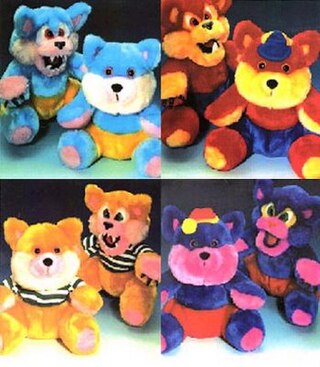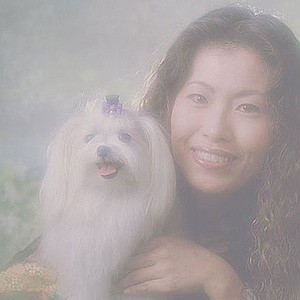
A teddy bear is a stuffed toy in the form of a bear. Developed apparently simultaneously by toymakers Morris Michtom in the U.S. and Richard Steiff under his aunt Margarete Steiff's company in Germany in the early 20th century, the teddy bear, named after President Theodore Roosevelt, became a popular children's toy and has been celebrated in story, song, and film.

Ilkley is a spa town and civil parish in the City of Bradford in West Yorkshire, in Northern England. Historically part of the West Riding of Yorkshire, Ilkley civil parish includes the adjacent village of Ben Rhydding and is a ward within the City of Bradford. Approximately 12 miles (19 km) north of Bradford and 17 miles (27 km) north-west of Leeds, the town lies mainly on the south bank of the River Wharfe in Wharfedale, one of the Yorkshire Dales.

A doll is a model typically of a human or humanoid character, often used as a toy for children. Dolls have also been used in traditional religious rituals throughout the world. Traditional dolls made of materials such as clay and wood are found in the Americas, Asia, Africa and Europe. The earliest documented dolls go back to the ancient civilizations of Egypt, Greece, and Rome. They have been made as crude, rudimentary playthings as well as elaborate art. Modern doll manufacturing has its roots in Germany, from the 15th century. With industrialization and new materials such as porcelain and plastic, dolls were increasingly mass-produced. During the 20th century, dolls became increasingly popular as collectibles.

The Raggy Dolls is a 1986-1994 British cartoon series which originally aired on ITV. The series is set in Mr Grimes' Toy Factory, where imperfect dolls are thrown into a reject bin. While unobserved by human eyes, the dolls come to life and climb out of the reject bin to have adventures. The series was designed to encourage children to think positively about physical disabilities. 112 episodes were produced.

A stuffed toy is a toy doll with an outer fabric sewn from a textile and stuffed with flexible material. They are known by many names, such as plush toys, plushies, stuffed animals, and stuffies; in Britain and Australia, they may also be called soft toys or cuddly toys. The stuffed toy originated from the Steiff company of Germany in the late 19th century and gained popularity following the creation of the teddy bear in the United States in 1903. At the same time, German toy inventor Richard Steiff designed a similar bear. In 1903, Peter Rabbit was the first fictional character to be made into a patented stuffed toy. In 1921, Christopher Robin's stuffed toy, given to him by his father, A. A. Milne, would inspire the creation of Winnie-the-Pooh. In the 1970s, London-based Hamleys, the world's oldest toy store, bought the rights to Paddington Bear stuffed toys. In the 1990s, Ty Warner created Beanie Babies, a series of animals stuffed with plastic pellets that were popular as collector's items.

Steiff is a German-based plush toy company, founded in 1880, with headquarters in Giengen, Germany. The company claims to have made the world's first factory-made teddy bear.

A dollhouse or doll's house is a toy house made in miniature. Since the early 20th century dollhouses have primarily been the domain of children, but their collection and crafting is also a hobby for many adults. English-speakers in North America commonly use the term dollhouse, but in the United Kingdom and other English-speaking countries the term is doll's house. They are often built to put dolls in.

Morris Michtom was a Russian-born businessman and inventor who, with his wife Rose, also a Russian Jewish immigrant who lived in Brooklyn, came up with the idea for the teddy bear in 1902 around the same time as Richard Steiff in Germany. They founded the Ideal Novelty and Toy Company which, after Michtom's death, became the largest doll-making company in the United States.

Merrythought is a toy manufacturing company established in 1930 in the United Kingdom. The company specialises in soft toys, especially teddy bears. Merrythought has handmade traditional teddy bears in the World Heritage Site of Ironbridge, Shropshire, UK since 1930.

Ideal Toy Company was an American toy company founded by Morris Michtom and his wife, Rose. During the post–World War II baby boom era, Ideal became the largest doll-making company in the United States. Their most popular dolls included Betsy Wetsy, Toni, Saucy Walker, Shirley Temple, Miss Revlon, Patti Playpal, Tammy, Thumbelina, Tiny Thumbelina, and Crissy. The company is also known for selling the Rubik's Cube.
The Forgotten Toys is a 1997-1999 British animated comedy television series based on the children's book The Night After Christmas. It was made by Hibbert Ralph Entertainment, featuring the voices of Joanna Lumley and Bob Hoskins. It is a poignant tale of abandoned toys who are searching for children to love them. It aired on CITV in the UK, on ABC in Australia.

The Museum of Childhood is a museum which houses a collection of children's toys and playthings, situated on the Royal Mile, in Edinburgh, Scotland. It was the first museum in the world to specialise in the history of childhood.

A toy museum is a museum for toys. They typically showcase toys from a particular culture or period with their history. These are distinct from children's museums, which are museums for children, and are often interactive – toy museums may be aimed at children or adults, and may have interactive exhibits or be exclusively for display.

Brighton Toy and Model Museum is an independent toy museum situated in Brighton, East Sussex. Its collection focuses on toys and models produced in the UK and Europe up until the mid-Twentieth Century, and occupies four thousand square feet of floor space within four of the early Victorian arches supporting the forecourt of Brighton railway station. Founded in 1991, the museum holds over ten thousand toys and models, including model train collections, puppets, Corgi, Dinky, Budgie Toys, construction toys and radio-controlled aircraft.

Winnie-the-Pooh is a fictional anthropomorphic teddy bear created by English author A. A. Milne and English illustrator E. H. Shepard. Winnie-the-Pooh first appeared by name in a children's story commissioned by London's Evening News for Christmas Eve 1925. The character is based on a stuffed toy that Milne had bought for his son Christopher Robin in Harrods department store.

The golliwog, also spelled golliwogg or shortened to golly, is a doll-like character, created by cartoonist and author Florence Kate Upton, which appeared in children's books in the late 19th century, usually depicted as a type of rag doll. It was reproduced, both by commercial and hobby toy-makers, as a children's soft toy called the "golliwog", a portmanteau of golly and polliwog, and had great popularity in the Southern United States, the UK, South Africa and Australia into the 1970s. The doll is characterised by jet black skin, eyes rimmed in white, exaggerated red lips and frizzy hair, based on the blackface minstrel tradition. Since the 20th century, the word has been considered a racial slur towards black people.

Hove Museum of Creativity is a municipally-owned museum in the town of Hove, which is part of the larger city of Brighton and Hove in the South East of England. The museum is part of Brighton & Hove Museums, and admission is free. Opened in 1927 by the Hove Corporation, the museum is located in a late 19th-century villa originally known as Brooker Hall.

The WereBears were a series of teddy bears released in 1983 in the United Kingdom. They were created by George Nicholas, a muralist and managing director with Impact Murals, philanthropist and director of his charity Art For Their Sake, cartoonist, animator, and author, so that boys could have teddy bears without worrying about being bullied. Nicholas gave the handling of distribution of the toys to UK-based toy company Hornby. The bears were designed in a way that their "normal" head functioned as a hood, and by turning the head inside out it would reveal the "were" face.

Michi Takahashi is a teddy bear artist in Japan. She is well known in the teddy bear industry in the world as the pioneer teddy bear artist in Japan, who enhanced the charm of teddy bear as an art, not just a stuffed toy. One of her masterpieces "Look Here Bees! I'm Good Boy Takuya!" was nominated for TOBY awards in 1996¸ and won the highest praise from teddy bear fans in the world. She depicted the art of Takuya Kimura, whom she admires. Michi is also an art producer, an art director, and a soft sculptor. Her husband, Hiro Takahashi, is also a teddy bear artist.

The National Transport and Toy Museum in Wānaka, New Zealand is one of the largest private collections in the Southern Hemisphere and displays a large collection of items including over 650 vehicles, 20 aircraft and 60,000 toys plus thousands of miscellaneous items. Owned and operated by one family, the museum is located adjacent to the Wānaka Airport on State Highway 6.




















